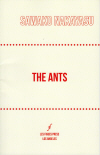The Ants
They populate cities, rural areas and suburbia. Outdoors they assemble in perfect formation between sidewalk cracks or pile on top of what must appear to them a Himalayan mountain of dirt. Their living arrangement is more noticeable and precarious if they take up residence inside a human home. Spiders are artisans; fireflies decorate summer night skies. Ants are just their industrious, ungainly selves.
They populate cities, rural areas and suburbia. Outdoors they assemble in perfect formation between sidewalk cracks or pile on top of what must appear to them a Himalayan mountain of dirt. Their living arrangement is more noticeable and precarious if they take up residence inside a human home. Spiders are artisans; fireflies decorate summer night skies. Ants are just their industrious, ungainly selves.
Or are they? Sawako Nakayasu’s meditation on The Ants goes beyond children tormenting them with sticks, politically correct Pixar storylines, or controlled classroom experiences, placing or imagining the insects on a human level.
The Ants is a series of unconnected short pieces either about ants or about the author’s fascination with them. As a kid, Nakayasu’s parents denied her repeated requests for an ant farm. Indeed, she traces her artistic development to using pencils filled with crushed ants, resulting in lines “coming out funny.” In this particular literary instance, adulthood has its advantages because she never has to search for her inspiration, and the styles she applies are impressive.
The two-paragraph “Harsh Edit” combines the absurd with the metaphorical when her editor demands more of what “looks cute” and the two-way revision process between writer and subject trying to broker “what is truly best for all of us involved.” Nakayasu never takes her editor’s advice to reduce her friends to cartoon level. They do not have cute names; they remain anonymous. The animation is in the writing, not the result. The author applies her impressive observation skills in several creative ways. “Apple Seed” is part field notes, part blank verse:
The time it takes for a single ant to eat an entire. Apple. The fact of the matter is, working along makes the task excruciatingly. Slow. Working alone, a single ant is unable to eat the entire. Thus a new replacement ant must.
The interaction between the author and subjects is more personal in “Carrot Cake,” which the ants “insultingly enough, did not find it good enough to eat,” and choose instead to live inside.
Most of the pieces explore life in the ant world. Nakayasu gives the insects human traits that, perhaps, are universal for all creatures. Some vignettes, such as “Ladybug” when a friendship ends because the ex-ant friend prefers the prettier insects, are humorous. Most are not. “Decay” is one ant’s desperate attempt to do something meaningful before its brief life ends. “Hazing” describes a rite of passage for those seeking indoor living accommodations. “Ant Liberation” follows “freethinking” ants from Yorba Linda, California conducting extensive research on finding the perfect home…only to have the author’s mother find them.
The Ants is a peek into an alternative world that exists a few steps away. Just be careful where you walk.





